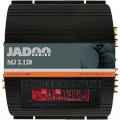Channel power (@2-ohms)
Rated power output by the amplifier per channel when a load (speakers) is connected to it with a nominal impedance of 2 ohms. For details, see "Nom. channel power (at 1 Ohm)”.
Channel power (@4-ohms)
Rated power output by the amplifier per channel when a load (speakers) with a nominal impedance of 4 ohms is connected to it. For details, see "Nom. channel power (at 1 Ohm)”.
Bridge connection
Rated power delivered by the amplifier to a load connected in a bridge circuit. For more information about the rated power, see "Nom. channel power (at 1 Ohm)”.
With a bridged connection, the speaker is connected not to one channel, but to two at the same time — the “positive” connector of one channel and the “negative” connector of the other are used. If the amplifier has a similar format of operation, then such a pair of channels operates in antiphase, due to which the power is summed up. This allows you to connect speakers to the amplifier, the power of which is twice the nominal power of the device: for example, at 150 watts per channel, 300 watts of acoustics can be bridged. If there are 4 or more channels, it becomes possible to use several speakers according to the "bridge" scheme. This is usually directly indicated in the specifications — for example, the entry "2x300 W" in the "Bridge connection" item means the ability to work with two speakers, each with 300 W.
The requirements for load resistance when connecting with a bridge are the same as for conventional; see "Maximum Resistance" for details.
Max. power
The highest
output power provided by the amplifier. It is worth noting that this indicator is not standardized, and different manufacturers may mean different values \u200b\u200bfor it — for example, the highest power of short-term, in a fraction of a second, peaks (power surges), the highest power that the amplifier can transfer for several seconds, or even the power at which the device will fail. Therefore, it makes no sense to compare different models with each other in terms of maximum power. But when choosing acoustics for an amplifier (or vice versa), this parameter can be very useful: it is desirable that the maximum power of the speaker be at least twice as high as that of the amplifier. This will reduce the risk that a power surge will damage the speakers.
Signal-to-noise ratio
One of the main parameters that determine the sound quality of the amplifier as a whole: it describes the ratio of the useful signal (in other words, “clean” sound) and various extraneous noises. This takes into account almost all noise — both due to external causes (for example, electrical "pickup"), and created by the device itself (for example, due to heating during operation). Accordingly, the higher the signal-to-noise ratio, the less audibility of various interferences and the clearer the sound is obtained (of course, under normal operating parameters). The average for car audio is 95-100 dB, but in advanced models this value
can be significantly higher.
At the same time, this parameter is not critical for monoblocks designed for subwoofers — most of the interference is high-frequency and will simply not be heard on the low-frequency speaker. The sound quality in this case is highly dependent on the characteristics of the speaker (much more than in multi-channel models), and is weakly related to the “noiselessness” of the amplifier.

